 Hi readers, it seems you use Catholic Online a lot; that's great! It's a little awkward to ask, but we need your help. If you have already donated, we sincerely thank you. We're not salespeople, but we depend on donations averaging $14.76 and fewer than 1% of readers give. If you donate just $5.00, the price of your coffee, Catholic Online School could keep thriving. Thank you. Help Now >
Hi readers, it seems you use Catholic Online a lot; that's great! It's a little awkward to ask, but we need your help. If you have already donated, we sincerely thank you. We're not salespeople, but we depend on donations averaging $14.76 and fewer than 1% of readers give. If you donate just $5.00, the price of your coffee, Catholic Online School could keep thriving. Thank you. Help Now >
Liturgical Use of Fire
FREE Catholic Classes
Fire is one of the most expressive and most ancient of liturgical symbols. All the creeds of antiquity accorded a prominent place to this element whose mysterious nature and irresistible power frequently caused it to be adored as a god. The sun, as the principle of heat and light for the earth, was regarded as an igneous mass and had its share in this worship. Christianity adapted this usual belief, but denied the divine title to heat and light, and made them the symbols of the divinity, which enlightens and warms humanity. The symbolism led quite naturally to the liturgical rite by which the Church on the Eve of Easter celebrates the mystery of the Death and Resurrection of Christ, of which the extinguished and rekindled fire furnishes the expressive image. The beginning of the office also reflects ancient beliefs. The new fire is struck from a flint and is blessed with this prayer :
Lord God, Almighty Father, inextinguishable light, Who hast created all light, bless this light sanctified andblessed by Thee, Who hast enlightened the whole world; make us enlightened by that light and inflamed with the fire of Thy brightness; and as Thou didst enlighten Moses when he went out of Egypt, so illuminate our hearts and senses that we may attain life and light everlasting through Christ our Lord. Amen.When the fire has been struck from the flint the three-branched candle is lighted and the deacon chants the "Exultet", a liturgical poem whose style is as lively and charming as the melody which accompanies it. It is yet preserved in the Roman Liturgy. In the East the ceremony of the new fire occupies a place of considerable importance in the paschal ritual of the Greek Church at Jerusalem. This ceremony is the occasion for scandalous demonstrations of a piety which frequently degenerates into orgies worthy of pagan rites. The Journal of the Marquis de Nointel, in the seventeenth century, relates scenes which cannot be transcribed and which take place periodically. This ceremony is peculiar to the Holy City and does not figure in the ordinary Byzantine ritual.
In the West we see the Irish, as early as the sixth century, lighting large fires at nightfall on the Eve of Easter. The correspondence of St. Boniface with Pope Zachary furnishes a curious detail on this subject. These fires were kindled, not with brands from other fires, but with lenses; they were therefore new fires. There is no trace of this custom in Gaul, where the Merovingian liturgical books are silent on the point. It is difficult to say what took place in Spain, for although the Mozarabic Missal contains a blessing of fire at the beginning of the vigil of Easter, it can hardly be admitted that this ceremony was primitive. It may have been inserted in this missal at a later date as it was in the Roman Missal, in the case of which fire is obtained from a flint and steel. It is possible that the custom, of Breton or Celtic origin, was imposed upon the Anglo-Saxons, and the missionaries of that nation brought it to the continent in the eighth century. An altogether different rite, though of similar meaning, was followed at Rome. On Holy Thursday, at the consecration of the holy chrism, there was collected in all the lamps of the Lateran basilica a quantity of oil sufficient to fill three large vases deposited in the corner of the church. Wicks burned in this oil until the night of Holy Saturday , when there were lighted from these lamps the candles and other luminaries by which, during the Eve of Easter , light was thrown on the ceremonies of the administration of baptism. The rite must have been attended with a certain solemnity since the letter of Pope Zachary to St. Boniface prescribes that a priest, perhaps even a bishop, should officiate on this occasion. Unhappily we are reduced to this somewhat vague information, for neither the Roman "Ordines", nor the Sacramentaries tell us anything concerning this ceremony. This blessing of the paschal candle and the fire at the beginning of Easter Eve is foreign to Rome. The large lamps prepared on Holy Thursday provided fire on the Friday and Saturday without necessitating the solemn production of a new fire. The feast of the Purification or Candlemas (2 February) has a celebrated rite with ancient prayers concerning the emission of liturgical fire and light. One of them invokes Christ as "the true light which enlightenest every man that cometh into this world". The canticle of Simeon, "Nunc Demittis", is chanted with the anthem "A light (which my eyes have seen) for the revelation of the Gentiles and for the glory of thy people Israel."
 Hi readers, it seems you use Catholic Online a lot; that's great! It's a little awkward to ask, but we need your help. If you have already donated, we sincerely thank you. We're not salespeople, but we depend on donations averaging $14.76 and fewer than 1% of readers give. If you donate just $5.00, the price of your coffee, Catholic Online School could keep thriving. Thank you. Help Now >
Hi readers, it seems you use Catholic Online a lot; that's great! It's a little awkward to ask, but we need your help. If you have already donated, we sincerely thank you. We're not salespeople, but we depend on donations averaging $14.76 and fewer than 1% of readers give. If you donate just $5.00, the price of your coffee, Catholic Online School could keep thriving. Thank you. Help Now >









 Daily Readings for Friday, April 19, 2024
Daily Readings for Friday, April 19, 2024 St. Alphege: Saint of the Day for Friday, April 19, 2024
St. Alphege: Saint of the Day for Friday, April 19, 2024 Stewardship Prayer: Prayer of the Day for Friday, April 19, 2024
Stewardship Prayer: Prayer of the Day for Friday, April 19, 2024